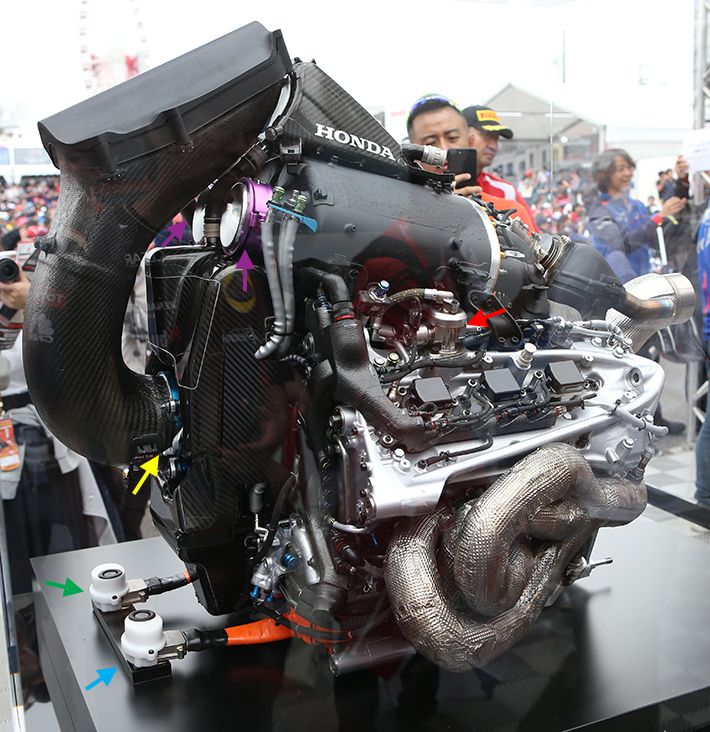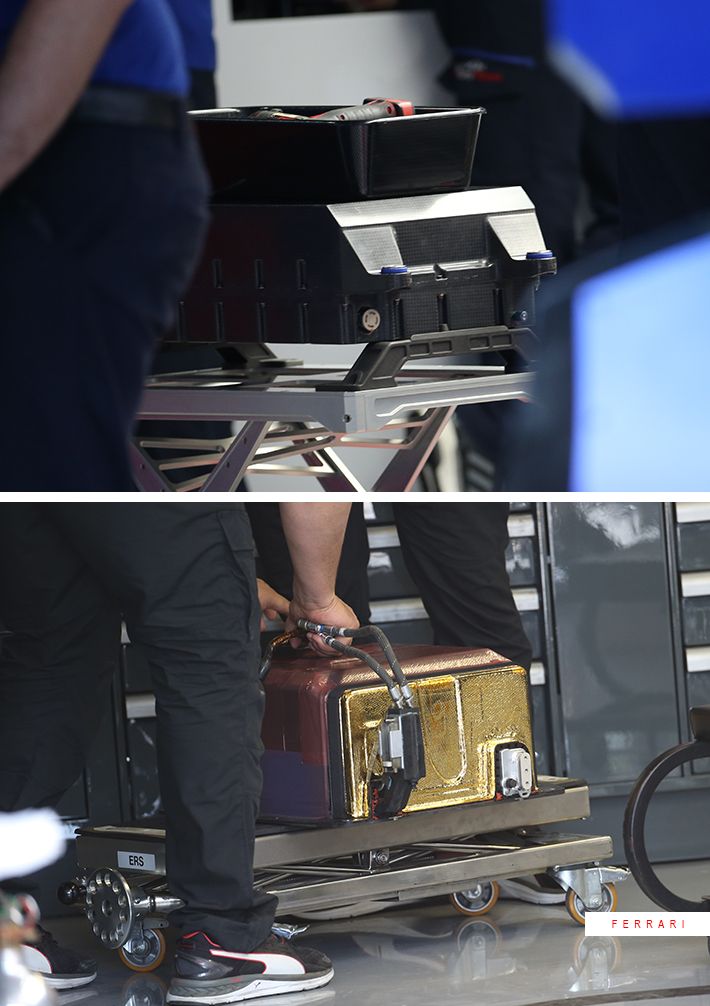From F1i.com by Nicolas Carpentiers 11/10/2018 at 11:00
With just a week between the Russian and Japanese Grands Prix, there were logically few technical evolutions implemented at Suzuka. However, the 17th round of the F1 world championship did offer a good opportunity to get a closer look at Honda’s latest-spec power unit.

ON HOME TURF
It has become a tradition in the Land of the Rising Sun: at its home race at Suzuka, Honda put its engine on display, exposing the layout of the RA618H that powers the Toro Rossos of Pierre Gasly and Brendon Hartley.
The Japanese V6 has retained the split architecture of its predecessors: turbine and compressor are dissociated and connected by a shaft on which is mounted the MGU-H. Since 2017, the compressor is no longer housed inside the "V" formed by the two banks of cylinders, but is installed at the front of the block, like the Mercedes V6. This positioning helped increase the size of the compressor and therefore the power, but it forced a redesign of the fuel tank, hollowed out like its counter-part on the Anglo-German engine.
As can be seen in the picture above, the compressor is fed with air by a periscope-shaped carbon duct, which passes through the oil tank, pierced in the middle (see the yellow arrow). On top are the two entries (purple arrows) through which compressed and cooled air (after passing through the intercooler) enters the air box.
One can also see one of the two direct injection pumps (red arrow). Driven by cam shafts, these pumps (one for each cylinder bank) deliver 500bar of pressure to the injector.
There are also three-phase cables (orange, as on all other engines) that transfer the AC power to the control box: it converts electricity to direct current so that the battery can store it. The green cable connects the MGU-H to the control unit, which is connected to the MGU-K by the blue cable.

COMPACT
Seen from behind, the Japanese six-cylinder shows the air box (yellow arrow), the two pipes of the wastegate (blue arrows), the turbine (red arrow) and the clutch, here hidden by a black cover (green arrow).
On the Honda block, the clutch is mounted on the thermal block rather than on the gearbox. The relatively low engine speed of the turbo V6 (limited to 15,000rpm) makes it possible to attach the clutch to the engine, a solution already seen in the past and preferable in view of the significant increase in torque compared to the previous atmospheric V8. This configuration is identical to the one used by Mercedes.

At Suzuka, we also got a good look at the battery of the Japanese V6 which seems very compact, especially compared to the system fitted to the Ferrari SF71H.
Top battery is Honda and lower is Ferrari
After the second specification, which appeared in Montreal, Honda introduced in Sochi the third and last evolution of its RA618H block. Although more powerful, this version posed driving problems to both drivers, the torque sometimes being delivered unpredictably. That's why Gasly and Hartley had to go back to the previous specification in qualifying and in the race in Russia.
To remedy this, Honda dyno-tested last week an optimized mapping, which improved the torque delivery and, therefore, mitigated the strong oscillations generated in the gearbox.
However, the problem doesn’t seem completely solved, with Gasly claiming to have encountered "serious oscillations when upshifting [during free practice on Saturday], [forcing him] to adopt a fairly conservative mode of exploitation". To solve it, at least partially, Honda obtained from the FIA an exemption regarding Parc Fermé rules to make an overnight change on Saturday evening. For some reason however, the FIA had a change of heart and instructed Toro Rosso, on the grid, to revert to its previous settings.
Whatever the case, the increase in power is real and has undoubtedly contributed to the good qualifying pace of the STR13 (with Hartley lining up P6 and Gasly P7): “From the performance point of view, we are happy. The post-shift oscillations, maybe some torque delivery at low-RPM, we will assess the data from here and can improve for the next race,” explained Honda technical director Toyoharu Tanabe.
Certainly, the reliability of the powertrain is not yet optimised, and its power is perhaps now only at the level of that of the Renault engine. Nevertheless, since partnering with Toro Rosso, Japanese engineers can work and make progress in a calmer environment, and can draw the lessons from possible mistakes in a better way.





